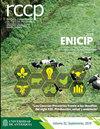添加硒酸钡对犊牛血清甲状腺素和三碘甲状腺原氨酸的影响
IF 0.5
4区 农林科学
Q4 AGRICULTURE, DAIRY & ANIMAL SCIENCE
引用次数: 0
摘要
背景:硒酸钡是一种无机硒源,用于治疗牛硒缺乏症的缓释制剂。目的:研究硒酸钡对犊牛血清中三碘甲状腺原氨酸(T3)和甲状腺素(T4)的影响。方法:6头黑弗里斯兰奶牛妊娠最后2个月皮下添加硒酸钡,直至产犊。6头奶牛作为对照。所有奶牛均饲喂低硒饲粮,由天然牧草干草和缺乏硒的商品精料组成。通过红细胞谷胱甘肽过氧化物酶(GPx)活性测定硒平衡。采用电化学发光法测定犊牛血清T3、T4浓度。结果:预备期补硒提高了奶牛GPx活性(p<0.05)。添加硒的犊牛血清硒平均浓度高于未添加硒的犊牛。与未添加组相比,添加组犊牛出生后1小时T3的平均浓度较低(p<0.05)。7日龄时,两组血清T4浓度均显著降低(p<0.05)。结论:在犊牛预备期给予硒酸钡可降低犊牛出生后1小时血清T3浓度。本文章由计算机程序翻译,如有差异,请以英文原文为准。
Serum concentration of thyroxine and triiodothyronine in newborn calves from cows supplemented with barium selenate
Background: Barium selenate is an inorganic source of selenium (Se) used in prolonged-release preparations to treat selenium deficiency in bovines. Objective: To evaluate serum concentrations of triiodothyronine (T3) and thyroxine (T4) hormones in newborn calves from mothers supplemented with barium selenate during prepartum. Methods: Six black Frisian pregnant cows were supplemented with barium selenate subcutaneously during the last two months of gestation, until calving. Six cows were used as controls. All cows were subjected to a low Se diet, consisting of hay from natural pasture and commercial concentrate lacking Se. The Se balance was measured through the activity of erythrocyte glutathione peroxidase (GPx). Serum concentration of T3 and T4 in calves was determined by electrochemiluminescence. Results: Se supplementation during prepartum increased GPx activity in cows from day 45 post-supplementation (p<0.05). Calves from supplemented mothers showed higher average serum Se concentration than calves from non-supplemented mothers. The average concentration of T3 in the calves from supplemented mothers was lower in the first hour of life (p<0.05) compared with calves from mothers of the non-supplemented group. A decrease (p<0.05) in T4 serum concentrations was observed in both groups at seven days of age. Conclusions: Administration of barium selenate to cows during prepartum generates a reduction in serum concentration of T3 in the first hour of life of calves.
求助全文
通过发布文献求助,成功后即可免费获取论文全文。
去求助
来源期刊

Revista Colombiana De Ciencias Pecuarias
AGRICULTURE, DAIRY & ANIMAL SCIENCE-
CiteScore
0.80
自引率
0.00%
发文量
18
审稿时长
6-12 weeks
期刊介绍:
The editors of Revista Colombiana de Ciencias Pecuarias (RCCP) welcome the submission of original manuscripts on experimental and clinical studies associated with the broad areas of animal sciences and veterinary medicine as they interface with biochemistry, molecular biology, physiology, pharmacology, toxicology, pathology, microbiology, parasitology, immunology and epidemiology. The scope of the journal includes studies of basic and applied research in animal management and production, feeding and nutrition, reproduction, breeding, genetics, animal welfare and behavior; as well as animal production focussed from biotechnology, soil science, agrostology, silvopastoral systems, livestock economics and the environment.
The criteria for acceptance of papers submitted for publication are originality, quality and clarity of the content. Each contribution must be based on original, unpublished research that has not been simultaneously submitted to other journals. All papers will be peer reviewed. All authors bear responsibility for ensuring the integrity and quality of their reported research. It is the author''s responsibility to secure permission to use figures or tables that have been published elsewhere.
Contributions may be classified as original research, review, rapid communication, clinical case studies or methodological articles, as well as news/commentaries or letters to the editor. Most review articles are invited by the editor. Authors interested in submitting a review article should contact the corresponding editor. Rapid publication of original manuscripts is a goal of the journal. Manuscripts must be written in English. Each manuscript is considered for publication with the understanding that it has not been simultaneously submitted to any other journal. Upon acceptance for publication, papers are subject to editorial review and revision.
 求助内容:
求助内容: 应助结果提醒方式:
应助结果提醒方式:


